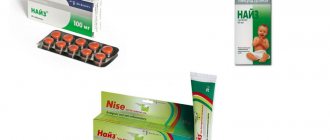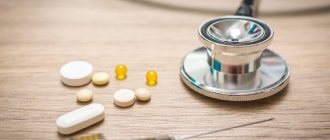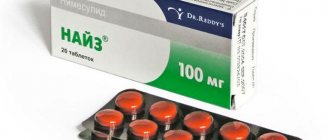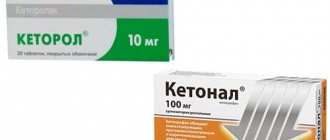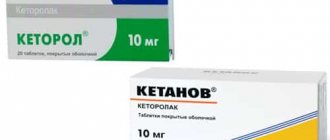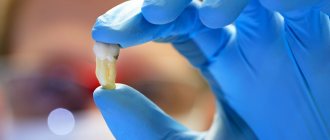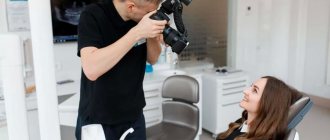A high-quality and rapid wound healing process after tooth extraction depends not only on the professionalism of the doctor who performed the extraction (removal) of the tooth, but on the correct behavior of the patient after the procedure, who must strictly follow the recommendations given by the doctor for the period of healing of the wound surface. If you correctly and clearly follow the advice of a specialist, the recovery process occurs quickly and as painlessly as possible.
For example, patients who do not listen to the recommendations given to them make rinsing movements in the area of the healing wound; this washes out the blood clot, which performs a protective function against the entry of bacteria and microbes, as a result of which there is a high risk of wound suppuration.
In this article we want to give recommendations on what should and can be done after tooth extraction, and what should not be done.
1. A gauze swab on the hole. When can it be taken out?
As a rule, the doctor does not immediately release the patient after removal, but asks him to wait for 15-20 minutes within the clinic to then examine and make sure that everything is in order with blood clotting and the tampon can be removed without fear. In rare cases, keeping the tampon in your mouth may take 30-40 minutes, usually 10-20 minutes. There is no need to keep it longer and it is even dangerous, because bacteria accumulate on it and there is a possibility of infection. There are exceptions, when the wound continues to bleed a little, then the old tampon is replaced with a new sterile one and kept for some time.
For some time, saliva may still be pinkish due to staining with secreted ichor, this should not be alarming, this situation can be distinguished from bleeding. At this moment, saliva can be easily swallowed; there is no need to accumulate it in the mouth.
Side effects and overdose
The most common consequences after treatment with Ketorol are disruption of the gastrointestinal tract. It is manifested by flatulence, a feeling of heaviness in the stomach and diarrhea. Typically, such manifestations occur in people over 65 years of age, since they are often diagnosed with chronic diseases of the gastrointestinal tract.
Other possible side effects from taking Ketorol include:
- excessive sweating;
- allergic reactions, manifested by skin rashes and difficulty breathing;
- swelling and redness of the face;
- dizziness;
- headache.
The likelihood of adverse reactions occurring depends on the dosage of the drug taken and the time for which it is taken. When overdosing on painkillers, people experience symptoms of intoxication:
- vomit;
- nausea;
- dehydration.
If these signs appear, you must rinse your stomach with water and take the sorbent. After this, Ketorol is stopped until you feel better.
2. After what time can you eat and drink?
After removal, you can drink water. After two hours you can eat. The limiting condition is not to chew rough food on the side of the extracted tooth in the first few days. Hard food can damage the blood clot, which is located in the socket and is needed for wound healing. If the patient experiences an acute feeling of hunger, then no one forbids eating cool yogurt or kefir. In the first days of healing of the hole, it is better to completely avoid eating rough, hard, solid foods, so as not to make strong chewing movements, as well as spicy, salty foods, so as not to irritate the oral mucosa. It is also important to monitor the temperature of food and drinks; they should not be too hot.
Operating principle
The main component of Ketorol has the ability to be absorbed from the intestines into the blood. It quickly penetrates the internal organs and tissues, thereby providing a rapid therapeutic effect. Ketorolac (active ingredient) has the ability to suppress the activity of enzymes that cause the production of prostaglandins. The substances are responsible for the susceptibility of pain, the development of the inflammatory process and an increase in body temperature.
Not all prostaglandins affect the development of the inflammatory process; some of them are necessary to protect the mucous membranes of the stomach from external irritants. 1st generation NSAIDs, which include Ketorol, block all types of hormones, therefore, with long-term use, an exacerbation of gastrointestinal diseases is possible. Because of this, the patient may feel discomfort in the upper abdomen. NSAIDs of the latest generations selectively block only those substances that are responsible for pain receptors and increased temperature.
3.Applying ice.
After tooth extraction in our Center, a specialist will give you ice specially prepared for such procedures to apply in the first hours after extraction. Ice is applied for a certain time, at certain intervals, which the doctor will instruct you about. At home, this procedure will need to be continued for some time (the first few hours after removal). This is done in order to minimize or completely eliminate tissue swelling.
Under no circumstances should you heat the area in the area of the extracted tooth; in this case, suppuration will develop.
When you shouldn't go to the doctor
Often, when eating, we are faced with the fact that our teeth respond to us with incomprehensible “signals” - they begin to “cramp” and itching appears. You shouldn’t immediately sound the alarm - these may not be signs of dental disease, but simply evidence of illiterate food intake. This reaction is often caused by eating food that is too cold or too warm, or, even worse, by suddenly changing cold and hot foods (and vice versa).
Sudden changes in temperature not only cause toothache, but can also seriously damage tooth enamel. You shouldn’t eat ice cream after a cup of hot coffee - this could result in your tooth simply cracking! If a tooth hurts due to temperature changes, the toothache itself in such cases does not pose a danger - it is a reaction of your teeth to a “stressful” situation for them.
Another feature of the body that can cause toothache is the teeth’s sensitive response to weather changes. Sub-zero temperatures and icy cold can cause minor toothache, which will not be a sign of serious illness. This is a normal reaction of the body to weather conditions. To reduce discomfort from extremely cold temperatures, wear warm hats, turtleneck sweaters, and scarves that cover your neck and lower face.
6. Medications after removal.
After the procedure, the doctor prescribes a number of medications to take. Under no circumstances should you take any medications on your own, without consulting a doctor.
Painkillers should be taken in case of pain, at intervals and in the amount recommended by the doctor. Each case is individual; it happens that the patient does without taking painkillers.
Antibiotics. In some cases, after removal, antibiotics are prescribed for 5-7 days. As a rule, these are situations when the doctor removes a tooth in the stage of inflammation, complex extraction or removal of several units of teeth. Only a specialist surgeon decides whether to take antibiotics or not.
Antihistamines. Reduces the likelihood of swelling.
Antiseptics. Used as a rinse. BUT, remembering that rinsing movements are prohibited in the first days. A small amount of solution is taken into the mouth and simply held in the mouth, then calmly spit out. Such baths must be done if the tooth was removed during the inflammation phase, if the flux was exposed, if there are teeth affected by caries in the oral cavity.
Contraindications
There are several prohibitions on taking the drug Ketorol. Among them are:
- pregnancy at any stage;
- breastfeeding (the active substance is absorbed into breast milk and enters the baby’s intestines);
- children under 16 years of age;
- severe renal or liver failure;
- allergy to auxiliary and active substances of the medication;
- diseases of the digestive tract that occur in acute form (gastritis, duodenal ulcer).
The instructions for use list in detail all diseases for which taking the medication is contraindicated. If you notice any side effects from treatment, you should immediately stop taking the medication and consult a doctor. Ketorol has analogues in terms of therapeutic action and duration of analgesic effect. One of the analogues of the drug with the same active ingredient is Nimesil, but unlike Ketorol it is produced in a more convenient form for use - in granules.
7.High blood pressure.
In patients with high blood pressure, there is a risk that the wound may bleed longer than usual. In this case, you need to regulate the pressure by taking appropriate medications to reduce it. In our SDent dental medical center, even before the start of manipulations, the doctor always finds out the main points about the general health of the patient. If the patient has hypertension, the specialist knows about this problem in advance and then gives the necessary recommendations appropriate to the case.
If your tooth hurts, you need to go to the doctor
Stitching and cutting toothache is a symptom of dental disease. They may be caused by the following reasons:
- poor oral hygiene;
- vitamin deficiency;
- decreased immunity;
- jaw injuries;
- incorrect position of teeth.
Only a dentist can make the correct diagnosis and prescribe an effective solution. Therefore, the surest way to deal with toothache is to visit a specialist as soon as possible. If you are experiencing similar pain right now, call 8 (495) 033-00-63 or fill out the online registration form. Tell the administrators about the pain that is bothering you, and they will find the next time for you to see a dentist.
8.What happens to the sutures after removal.
After the tooth is removed, the surgeon places sutures on the wound surface. This promotes faster healing, reduced pain, less risk of inflammation, minimizes the risk of bleeding, and protects the blood clot from falling out.
At the SDent clinic we use the most modern and safe materials. The thread with which the surgeon sews the edges of the hole is self-absorbing. But during the process, the ends of the thread can cause discomfort to the patient and interfere with the oral cavity. Therefore, for the comfort and safety of the patient, the doctor always sets an appointment date for examination and removal of sutures in approximately 10 days.
Composition and release form
Ketorol is available in two pharmacological forms - tablets and injections. The active ingredient in its composition is ketorolac. It has a powerful anti-inflammatory effect and is even used to relieve severe toothaches caused by pulpitis or maxillofacial injuries.
In addition to the active substance, the tablets contain lactose and starch. For people who are allergic to milk protein, it is better to give preference to the drug in the form of injections. The effect of Ketorol in the fight against pain is often equated to the therapeutic effect of narcotic medications. But adverse reactions from its use are observed much less frequently.
After tooth extraction, you should not do the following.
- In the first couple of days, taking a hot bath is excluded, only a warm shower.
- During sleep, you need to be careful not to lie on the side where the tooth was removed, this provokes the appearance of swelling.
- Visiting the gym and active physical activity should be postponed in the first days.
- Do not touch the wound with your tongue or foreign object.
- Do not open your mouth very wide, do not use active chewing and facial movements to avoid the sutures coming apart.
- Aspirin is not suitable as an anesthetic due to the fact that it has a thinning effect on the blood and may cause bleeding and hematoma.
- Do not rinse during the first few days. This can negatively affect the loss of a blood clot from the socket and the occurrence of inflammation.
For more information and to make an appointment with a specialist, call:
+7,
Ketorol® Express
The simultaneous use of ketorolac with acetylsalicylic acid or other NSAIDs, calcium preparations, glucocorticosteroids, ethanol, corticotropin can lead to a significant increase in the risk of adverse reactions, including the formation of gastrointestinal ulcers and the development of gastrointestinal bleeding.
When ketorolac is used simultaneously with other NSAIDs (including COX-2 inhibitors), fluid retention, cardiac decompensation, and increased blood pressure may occur.
Concomitant use of ketorolac with indirect anticoagulants, thrombolytics, antiplatelet agents, cefoperazone, cefotetan and pentoxifylline increases the risk of bleeding.
Probenecid reduces the plasma clearance and volume of distribution of ketorolac, increases its concentration in the blood plasma and increases its T1/2.
The combined use of ketorolac with valproate causes disruption of platelet aggregation.
When using ketorolac with other nephrotoxic drugs (including gold preparations), the risk of developing nephrotoxicity increases. Combined use with paracetamol increases the nephrotoxicity of ketorolac.
Drugs that block tubular secretion reduce the clearance of ketorolac and increase its concentration in the blood plasma.
The combined use of ketorolac with methotrexate increases the hepato- and nephrotoxicity of methotrexate. The combined use of ketorolac and methotrexate is possible only when using low doses of the latter. The clearance of methotrexate may decrease (it is necessary to monitor the concentration of methotrexate in the blood plasma).
With the use of ketorolac, it is possible to reduce the clearance of lithium, increase its concentration in the blood plasma and increase the toxic effect of lithium. Simultaneous use with lithium salts is contraindicated.
Ketorolac reduces the effect of antihypertensive and diuretic drugs (the synthesis of prostaglandins in the kidneys is reduced).
Ketorolac enhances the effect of narcotic analgesics. When combined with opioid analgesics, the doses of the latter can be significantly reduced. Ketorolac enhances the hypoglycemic effect of insulin and oral hypoglycemic drugs, and therefore it is necessary to recalculate the dose of these drugs.
Ketorolac increases the plasma concentrations of verapamil and nifedipine. Concomitant use of NSAIDs and mifepristone may reduce the effectiveness of mifepristone. NSAIDs are not recommended for use within 8-12 days after using mifepristone.
Concomitant use of NSAIDs and cyclosporine increases the risk of nephrotoxicity.
The simultaneous use of NSAIDs and quinolone antibiotics increases the risk of developing seizures.
Concomitant use of NSAIDs and tacrolimus increases the risk of nephrotoxicity.
Concomitant use of NSAIDs and zidovudine increases the risk of hematological toxicity.
When used simultaneously with digoxin, ketorolac does not interfere with the binding of digoxin to plasma proteins. Therapeutic concentrations of digoxin do not affect the binding of ketorolac to plasma proteins.
Antacids do not affect the absorption of ketorolac.
Myelotoxic drugs increase the manifestations of hematotoxicity of ketorolac.
